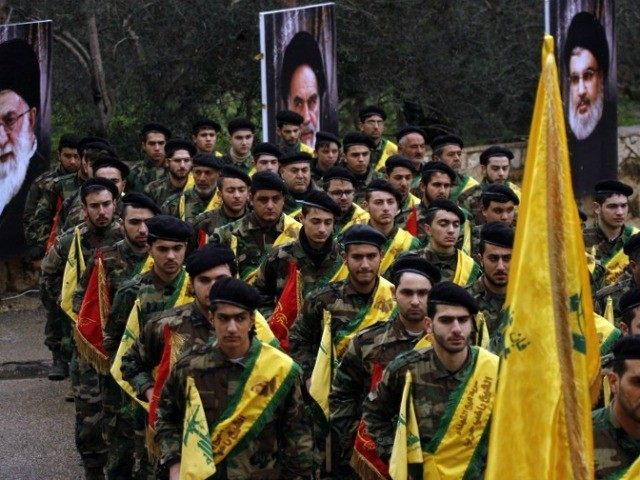A new blockbuster report in Argentine news outlet Infobae claims that Hezbollah generates between $60 to $100 million dollars a year in illegal activities in Latin America, particularly in the Tri-Border area uniting Paraguay, Argentina, and Brazil. The piece echoes years of reporting warning that the Lebanese Shiite terrorist group has expanded its influence in the region.
Infobae reports that the astronomical sum was revealed to them by “sources within French intelligence,” who calculated this based on the numerous businesses that Hezbollah members are involved in throughout the region, particularly drug and arms trafficking and money laundering. The report describes the Tri-Border region as Hezbollah’s “capital,” from which $10 million annually flow into Lebanon alone. If the capital had a “municipal building,” it would be the Galeria Page mall, which the outlet claims is “under the control of the Shiite militia” and used to launder illicit money through its sales.
In 2006, the United States Department of Treasury identified the Galeria Page’s owner, Muhammad Yusif Abdallah, as “a senior Hizballah leader in the TBA [Tri-Border Area] and an important contributor of funds to Hizballah, notably hosting a fundraiser for the terrorist group in the TBA in 2004.” The same press release described the mall as “serv[ing] as a source of fundraising for Hizballah in the TBA and is locally considered the central headquarters for Hizballah members in the TBA.”
The Infobae report claims this situation has not changed since 2006 but, rather, expanded. “Mosques, Islamic cultural centers, businesses and other organizations without apparent political ties unite hundreds of members, which in many cases are ‘used’ by the terrorist group” to generate funding, Infobae notes.
Infobae concludes by noting that Hezbollah has ties to drug trafficking groups in Mexico and negotiates with the world’s largest non-jihadist terror group, the Revolutionary Armed Forces of Colombia (FARC), using their “comparative advantage” to work and profit together.
While the Infobae report cites only anonymous French intelligence sources, the information presented reads as an update of a number of research reports and remarks by national security officials throughout the years warning of the growing threat of Hezbollah.
As recently as 2006, NBC News reported that Hezbollah had firmly rooted itself in the Tri-Border area. Noting that the Shiite terror group had established itself even in the 1990s, having taken part in the 1994 bombing of the Argentine-Israeli Mutual Association (AMIA), NBC and Telemundo reported that Hezbollah had created “an extensive smuggling network” that “funnels large sums of money to militia leaders in the Middle East” from its base in Latin America.
The NBC report quotes former FBI Director Louis Freeh as describing the Tri-Border Area in 1998 as a “free zone for significant criminal activity, including people who are organized to commit acts of terrorism,” making it long attractive to a group like Hezbollah. “The northern region of Argentina, the eastern region of Paraguay and even Brazil are large terrains, and they have an organized training and recruitment camp for terrorists,” Edward Luttwak, a counterterrorism expert with the Pentagon’s National Security Study Group, told NBC at the time.
The NBC report was met at the time only with major criticism from Al Jazeera, where a columnist called the links between Hezbollah and Latin America “tragicomic” attempts.
The major change that has occurred in the development of Hezbollah’s relations with Latin America between 2006 and now is that it has expanded its sphere of influence, thanks to Iranian diplomacy with Argentina and, especially, Venezuela, where late dictator Hugo Chávez allowed them to establish a second satellite in Latin America. In a statement this March, U.S. Southcom Commander Gen. John Kelly warned that Iran had established “more than 80 cultural centers” in Latin America. “As the foremost state sponsor of terrorism, Iran’s involvement in the region and these cultural centers is a matter for concern, and its diplomatic, economic, and political engagement is closely monitored,” added Gen. Kelly.
Iran hosted only 36 cultural centers in Latin America in 2012, a Breitbart News report found.
Southcom had warned for years that Hezbollah had been “planting agents and recruiting sympathizers among Arab and Muslim immigrants in the TBA,” according to a 2013 article by Matthew Levitt on the terror group’s influence in Latin America in the Journal of International Security Affairs. That report also mentions the Galeria Page mall as “a source of fundraising for Hezbollah in the TBA, the U.S. Treasury Department noted when the center was blacklisted in December 2006.”
The Levitt article also alleges that Hezbollah had worked to procure Latin American passports to travel more easily between nations in the Western Hemisphere. Levitt writes that at least one Hezbollah operative working at the Galeria Page, Assad Barakat, tricked the nation of Belize into issuing him a passport under the name of a Belizean infant who had died before turning a year old.
Hezbollah members operating out of Venezuela did not have to trick official to receive passports. Multiple reports have alleged that the Chávez government worked with Cuba to falsify passports for Hezbollah operatives. At least one report by a defecting high-ranking Venezuelan government official claims current President Nicolás Maduro met with Hezbollah leader Hassan Nasrallah in 2007 to discuss “drug trafficking, money laundering, the distribution of arms and issuing of passports … to terrorists.”
In March, Deputy Commander of Southcom Lt. Gen. Kenneth Tovo reiterated to Congress that Hezbollah generates “tens of millions” in drug trafficking in Latin America.

COMMENTS
Please let us know if you're having issues with commenting.